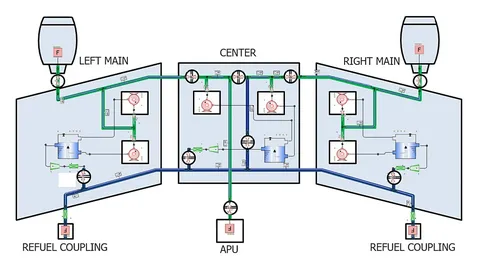Aircraft fuel systems are indeed intricate and essential for the safe and efficient operation of aircraft. Let’s delve deeper into each aspect to provide a comprehensive understanding of these crucial systems:
1. Importance of Aircraft Fuel Systems
The aircraft fuel system is a critical component that directly impacts flight performance, range, and safety. It ensures that the aircraft’s engines receive a continuous and adequate supply of fuel during all phases of flight. Without a reliable fuel system, the aircraft’s ability to function optimally and safely would be compromised.
Aircraft fuel systems are complex networks designed to manage fuel storage, distribution, and delivery to engines efficiently and safely. These systems consist of multiple components, including fuel tanks, pumps, valves, and lines, which work together to ensure a continuous fuel supply under various flight conditions.
Fuel tanks, often located in the wings, fuselage, or even the tail, store the fuel. Pumps transfer fuel from these tanks to the engines, while valves control the flow, allowing pilots to select fuel sources or isolate tanks as needed. Modern aircraft utilize advanced fuel management systems that automate these processes, optimizing fuel usage and maintaining balance to ensure stable flight.
Efficiency is achieved through precise fuel monitoring and management, reducing wastage and enhancing range. Additionally, fuel systems are designed to handle extreme conditions, such as high altitude and temperature variations, ensuring reliability. Thus, aircraft fuel systems are pivotal in maintaining flight safety, performance, and operational efficiency.
2. Anatomy of Aircraft Fuel Systems
2.1 Fuel Tanks
Fuel tanks are integral parts of the aircraft’s structure, strategically located to maintain balance and stability. They store the fuel required for the aircraft’s operation throughout its journey.
2.2 Fuel Lines and Pumps
Fuel lines transport fuel from the tanks to the engines. They are designed to withstand high pressure and temperature conditions to ensure the uninterrupted flow of fuel. Fuel pumps play a crucial role in maintaining the required pressure and flow rate of fuel.
2.3 Fuel Filters
Fuel filters are installed in the fuel system to remove contaminants and impurities from the fuel. Clean fuel is essential for engine performance, as any debris or contaminants can damage engine components.
2.4 Fuel Control Systems
Fuel control systems regulate the flow of fuel to the engines based on various parameters such as altitude, power settings, and flight conditions. They ensure that the engines receive the correct fuel-air mixture for efficient combustion and optimal performance.
3. Functionality of Aircraft Fuel Systems
3.1 Fuel Management
Fuel management systems monitor fuel levels, consumption rates, and distribution among tanks to maintain balance and stability. They optimize fuel usage to enhance flight performance and range.
3.2 Emergency Systems
Modern aircraft are equipped with emergency fuel systems that include backup pumps and cross-feed capabilities. These systems are designed to handle fuel-related emergencies or system failures, ensuring safety and reliability during flights.
4. Efficiency in Aircraft Fuel Systems
4.1 Fuel Efficiency Technologies
Advancements in aviation technology have led to the development of fuel-efficient systems. These include fuel-saving engines, aerodynamic improvements, and advanced fuel management software, all aimed at reducing fuel consumption and environmental impact.
4.2 Maintenance and Inspections
Regular maintenance and inspections are crucial for ensuring the efficiency and safety of aircraft fuel systems. This includes routine checks, fuel quality assessments, and system integrity tests to prevent malfunctions and ensure optimal performance.
5. Conclusion: Optimizing Aircraft Fuel Systems
In conclusion, aircraft fuel systems are complex but vital components that contribute significantly to flight safety, performance, and efficiency. Understanding their anatomy, function, and efficiency is essential for aviation professionals to ensure smooth and reliable operations. By embracing technological advancements, adhering to maintenance protocols, and prioritizing fuel management strategies, aircraft operators can optimize fuel systems for enhanced performance and sustainability in aviation.




